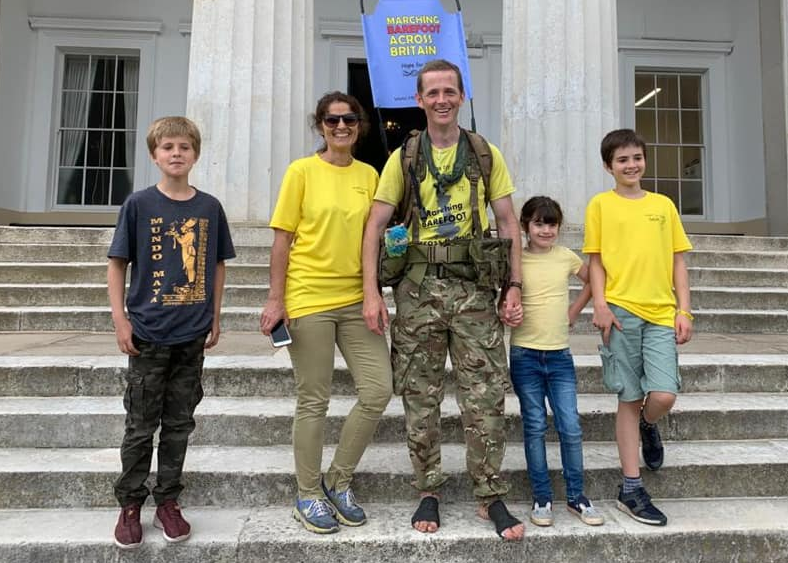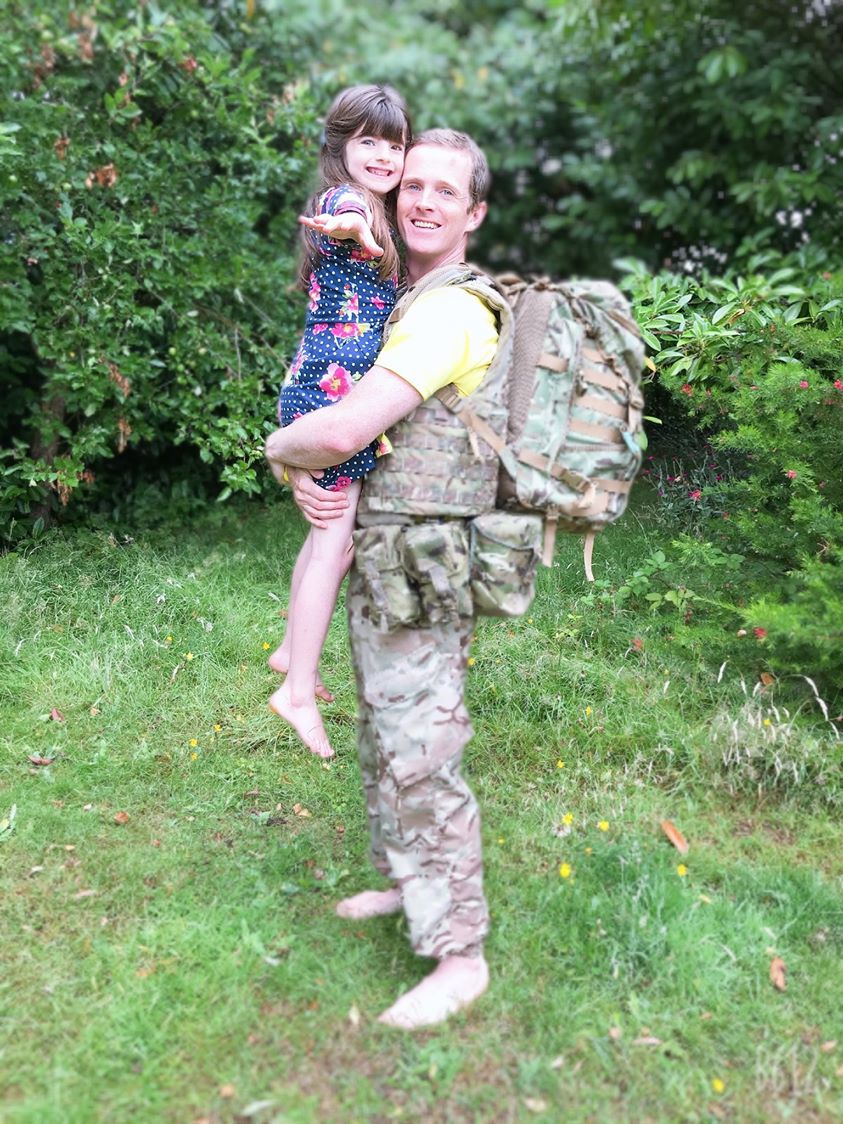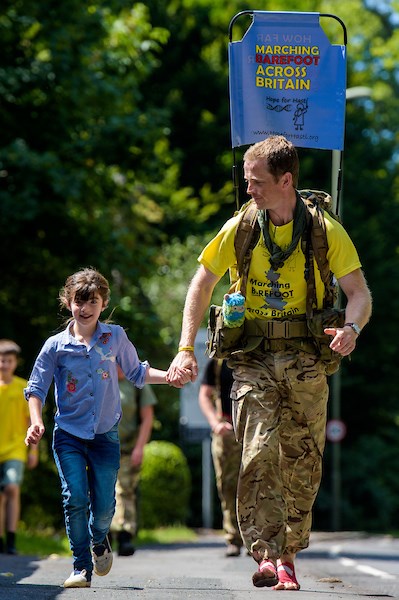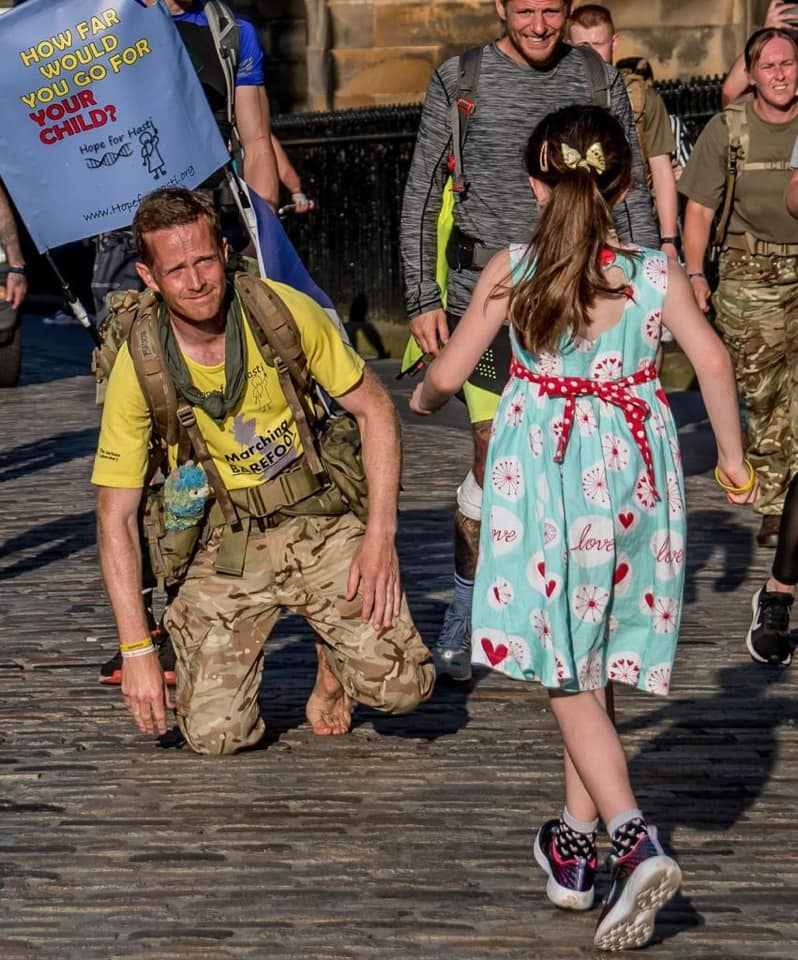
Chris Brannigan has recently completed a 700 mile trek barefoot across England to raise awareness for the rare disease affecting his daughter Hasti: Cornelia de Lange syndrome (CdLS). The march took 35 days, but it is only the start of the Brannigan’s rare disease odyssey.
Chris Brannigan is still filled with a swirl of emotions when he thinks back on his march. Now only a few weeks out from his grueling bootless trek, Brannigan has been amazed at the genuine outpouring of kindness from strangers, and haunted by the brutal hike. “I have nightmares from it,” Chris says, “Seriously. But it was the support from strangers that got me through it.”
Every journey has a beginning
To understand why this father of three would embark on this harsh challenge, you would need to go back to the birth of his youngest child: his daughter Hasti. From the early days, Chris and his wife Hengameh Delfaninejad knew that there was something different about Hasti. She couldn’t properly walk until age two and couldn’t speak until five. As parents, their insight told them this was wasn’t right, but they couldn’t seem to get a diagnosis no matter where they went. “It’s stressful enough having a young, sick child, but it’s absolutely heartbreaking when no one seems able to make your child feel better,” Brannigan said.

All the doctors that the family went to in the early days had more or less the same thing to say: There’s nothing that can be done. Basically, Brannigan would have to just accept that his daughter would need constant care for the rest of her life. A family of fighters, they refused to give up and kept reaching out and searching. Everything finally changed once they received a diagnosis last year: the rare disease Cornelia de Lange syndrome (CdLS).
This rare disease presents differently in kids, but broadly affects physical growth and development as well as impacting cognition and mental health. The result of one gene malfunction, CdLS often means that those affected will require daily therapy and constant care. With no immediate gene therapy available, this diagnosis was the start of the family’s rare disease “odyssey”: a term used in the rare disease community that encompasses the Herculean task of going from diagnosis to treatment, a process that often takes years and becomes an all-encompassing uphill battle.
The first steps of the long odyssey
After receiving the diagnosis, the family took another route: consulting with area geneticists. This proved to be another disappointment, as everyone they talked to in their region of England seemed to echo the first round of responses — there’s nothing that can be done. Refusing to believe such a final statement, the family got to researching on their own. After reading all available literature on CdLS, the family began sending emails and phone calls to every doctor and researcher on the planet they could reach (including Cat Lutz, Ph.D.The primary research goals of the Lutz lab involve developing preclinical mouse models of neurodegeneration to test therapeutics and inform clinical trials.Cat Lutz, Ph.D. , director of the JAX Rare and Orphan Disease Center). This time they received positive news: Gene therapy was a possibility, but there was a catch — the cost would be enormous and not covered by any insurance.
This brought the family to a crossroads. The best solution to this problem was to start a licensed charity for fundraising. But there were issues to consider. First, they hadn’t even told everyone in their family about Hasti’s diagnosis, and if the charity was started, Hasti and her family would be thrust irrevocably into the public spotlight. Second, the family was just an ordinary British family. They didn’t have a marketing or nonprofit background, there were no super-wealthy extended family members waiting in the wings, and ultimately all of this charity work would be brand new to them.

Realizing that there was little other choice to help Hasti, the family entered the world of nonprofit charities. But it wasn’t easy. “Just registering for the charity alone was a minefield,” Brannigan said, “Asking people for money is always hard, but even harder is knowing how to message properly as an organization.”
Nonetheless, Hope for Hasti was created in January 2020, a full-scale operation run by Chris and Hengameh. Chris is quick to point out that Hengameh did a lot of the work in getting the web, social and outreach systems in place. Using her knowledge of technology and IT, Hengameh finalized the website and guided the process of getting Hasti’s story out to the world.
A journey filled with great obstacles
With the website up and running, and work beginning on asking for donations, it quickly became obvious that to raise enough money to conduct the research for possible gene therapy they would need to do something big. Hengameh saw that they needed something that could grab peoples’ attention and hold it for a while. A major in the Army, Brannigan toyed with the idea of a march of some kind, an activity he was well acquainted with. Thinking about raising the stakes, Hengameh suggested a barefoot march, an idea which quickly turned into Chris’ 700-mile barefooted challenge.
As soon as quarantine was lifted (another issue that severely impacted the charity’s fundraising ability), Chris set out from Land’s End in Cornwall, in the southwestern corner of England, with his military kit complete with a backpack with his tent and some other essentials. The only thing he didn’t bring were his boots. He had just been training for the past few weeks, and he was fueled by a father’s love for his sick child, but, “within around 20 minutes of starting,” Chris said, “I realized that my assumptions and planning were wrong. This was going to be much harder than I thought.”
His bare feet, marching over uneven and sharp terrain (unlike the smooth sidewalks he trained on back home), were banged up within 60 minutes, and soon he was only walking about half the mileage he was hoping to cover per day. This began an ordeal of “high highs, and low lows,” as Chris explained it. The low points were some of the darkest he’s ever had to face. Getting into a minor accident, he ended up in the hospital fairly early in his walk. The doctor told him to stop the march immediately, but Chris needed to keep going as he had an appointment to render a petition to the Prime Minister. He made the appointment, but the pain never really left his battered feet for the rest of the walk.
The things that keep us going
Days later, walking through Exeter, Chris simply collapsed, totally exhausted and beyond the point of pain. Finding himself at the absolute limit of human endurance, he couldn’t see a way forward. Then, out of nowhere, a car pulled up. A stranger (who had been following Chris’ journey on Facebook) helped him to his feet and escorted him to a place to rest up and grab some food.
These acts of kindness are what kept Chris going. The Exeter story was something that would happen fairly often, but it seemed that every time he began to fail, there were strangers waiting to help him out and keep him going: with food, lodging, well-wishes and financial support for the charity. Whether it was other members of the military, neighborhood groups or just kind-hearted individuals (some who drove up from hours away), Chris fully acknowledges that it was this support that really helped him keep going.
The final day of the trek is one Chris says he will never forget. For the previous 34 days, Chris would wake up with dread in his heart: having a hard time getting started on the uncompromising road he was walking. On day 35, though, he woke up relieved. He knew today was the day he would finish the battle. Seeing Edinburgh in the distance, Chris could hear the bagpipes in the distance. Soon a group of motorcyclists formed an escort around him, an honor guard to escort him into the city. Getting close to the finish, in the heart of Edinburgh, he could see Hasti waiting for him. As she ran up to hug him, Chris dropped to a knee, unable to walk. The pain of over a month of barefoot marching, mixed with relief and love, left Chris just enjoying the moment with his daughter, alone even though he was in a crowd of cheering supporters.

One chapter ends, many more lie ahead
With the journey over, Chris was pleased to report that they made enough money to fund the proof of concept for JAX’s research. While this is amazing news for the family, looming obstacles still block the way for Hasti’s gene therapy. The biggest one is the cost of clinical trials, something that is measured in millions of dollars. Chris admitted that they have no idea how they’d even approach such a number, but he’s trying to enjoy the well-earned victory they just made before worrying about the next battle.
So the odyssey continues for Chris and Hengameh, as they try to form partnerships with other families, groups and institutions. All they ever wanted was for Hasti to have a normal life and be able to live happily, healthy and independently, but now they see that their struggles could potentially help other families struggling with CdLS or starting their own rare disease odyssey.
On that front, Chris has advice. “Read and research, become your own expert. Find the people who know, call them and email them. Above all else, never give up. There will always be setbacks and obstacles, but there’s also always a glimmer of hope.”
This glimmer of hope can be seen in the amazing pictures on the Hope for Hasti Facebook page, which you can visit here. It also pays to remember that this monumental challenge of Chris and his family is one shared by millions of people affected by rare diseases worldwide. For more information on what JAX is doing to help the fight against rare disease, and a place to start your own rare disease odyssey, click here.
Update 11/10/2020
Chris' amazing trek recently earned him a Pride of Britain win. This award is given out to people who have put forth remarkable effort to make the world a better place; a criteria that his long march certainly met. This award also came with a special video message from Hasti's favorite singer, Taylor Swift, who wanted to chime in with her support and admiration for the family!
Update 10/13/2021
Chris recently embarked on a barefoot US trek and along the way stopped at the Jackson Laboratory for Genomic Medicine for a brief reception. Hear comments from Chris and from JAX-GM's Scientific Director and Professor Charles Lee in the video below.
Chris Brannigan receives send-off at The Jackson Laboratory for Genomic Medicine during his barefoot march
Hear Chris Brannigan's story about his family's fight with rare disease and comments from JAX-GM's Director and Professor Charles Lee in this video from the Jackson Laboratory.